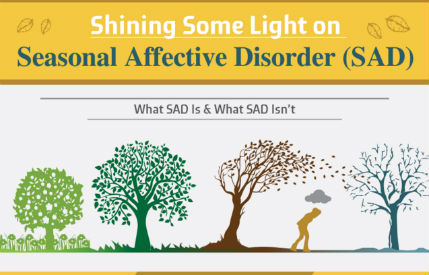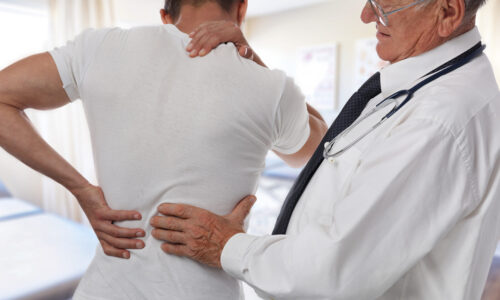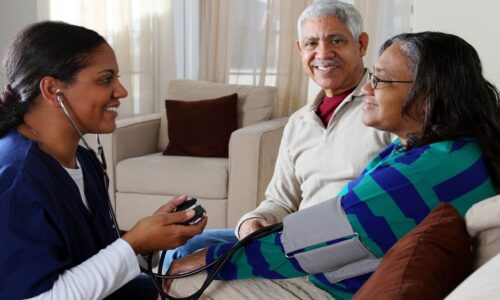Seasonal affective disorder (SAD) can make you feel miserable all winter long. The cold and dark days of winter can drag on, until it seems that spring will never come. Fortunately, there are some things you can do to alleviate your symptoms. One of the best types of natural therapy for SAD is physical exercise.

Topics Covered
What Is Seasonal Affective Disorder?
Seasonal affective disorder is a type of depression with symptoms that occur during the colder, darker winter months. During this time, you have symptoms of depression that can range from mild to severe. It can start in late autumn and last through spring. If you have SAD, you have depression in winter over multiple years.
Symptoms of SAD include:
- Oversleeping
- Difficulty concentrating, especially in the afternoon and evening
- Trouble waking up
- Feelings of guilt
- Feeling sluggish
- Isolating yourself from friends and family members
- Irritability
- Sadness
- Appetite changes
- Weight changes
- Loss of interest in activities you usually enjoy
- Decreased libido
- Suicidal thoughts or plans
How Can Exercise Help with SAD?
Exercise helps alleviate the symptoms of SAD in several ways. First, as you work out, your brain releases chemicals like serotonin and endorphins that decrease pain and improve your mood. It energizes you so that you feel less sluggish and sleepy. If you exercise outside, you get the benefit of natural light and fresh air, too. Do it in a natural environment, and you feel more relaxed and calmer.
What Kind of Exercise Works?
Researchers have investigated whether different types of exercise improve symptoms of depression more than others. The results are inconclusive, but it appears that just about any type of exercise can help.
Aerobic Exercise
Aerobic exercise is any type of exercise that uses aerobic metabolism. What does that mean? It means the cellular reactions in your body use a lot of oxygen during this type of exercise. Over time, doing aerobic exercises regularly improves your lungs’ ability take in oxygen. It aids in the delivery of oxygen throughout your body. With time, your lungs can take in more oxygen, your heart becomes more efficient, and your muscles can use oxygen better.
Benefits of Aerobics for SAD
The benefits of aerobic exercise for SAD and other mental health concerns include: increased self-confidence, greater emotional stability, and improved memory and brain function. As you exercise aerobically, you not only feel physically better, but you also feel more mentally alert. You feel more capable of working and socializing, and you gain confidence as you improve your physical fitness and appearance.
Types of Aerobic Exercise
Aerobic exercise, also called cardio exercise, includes exercises like:
- Speed walking
- Running
- Climbing stairs
- Cycling
- Swimming
- Rowing
- Jumping rope
- HIIT (High Intensity Interval Training)
How Much Aerobic Exercise Do I Need?
Any amount of exercise is better than none. However, if you don’t spend enough time exercising, you aren’t likely to notice much difference in the way you feel. While researchers haven’t identified the exact amount of exercise you need to reduce symptoms of SAD, the CDC has guidelines for general health.
The CDC recommends you get at least 150 minutes per week of cardio exercise each week. That may sound like a lot, but if you spread it out over five days, that’s only 30 minutes per day. Also, the CDC suggests that if you engage in more intense exercise, you can cut the time back to 75 minutes per week.
These are minimums. If you want to get the most health benefits from exercise, you need to bump it up to 300 minutes of moderate aerobic exercise or 150 minutes of intense cardio per week.
Strength Training
Strength training is the type of exercise that relies on muscular contraction working against resistance to build strength and endurance. Strength training is mainly an anaerobic exercise. The most common type of strength training is lifting weights. You may also use resistance bands, bodyweight exercises, or certain types of gym equipment to build strength.
Benefits of Strength Training for SAD
For a long time, experts assumed that only aerobic exercise could help relieve depression. However, more recently, studies have shown that anaerobic resistance training also decreases depression symptoms.
While more studies need to be done, it seems at this point that strength training may boost your levels of feel-good chemicals like dopamine, norepinephrine, and serotonin. It improves cognitive function, too.
As with any intense exercise, strength training can improve your confidence as you gain mastery, get in better condition, and improve your physical appearance. You feel stronger, so work, family chores, and play seem easier, too. As a bonus, you sleep better at night.
Types of Strength Training
There are many different types of strength training. If you’re new to anaerobic exercise, it’s best to work with a trainer who can teach you the right techniques and spot you for safety. Here are some of the most popular types of strength training exercises:
- Squats
- Push-ups
- Planks
- Rows
- Deadlifts
- Training with resistance bands
How Many Repetitions Should I Do?
Where should you start with anaerobic exercise? It really depends on your current condition. It’s always best to work with a trainer, especially in the beginning. Whatever you do, you should start with little weight and few repetitions and sets. You can increase gradually as you’re able to add more weight and reps.
Exercise Tips for People with SAD
Some things about exercise are the same for everyone who wants to be healthy. People who have seasonal affective disorder can benefit even more if they follow a few simple tips.
Exercise in Natural Light
Absorbing natural light is a key element of treatment for SAD. In fact, light therapy is the most common therapy for seasonal affective disorder. As you expose yourself to sunlight, you increase your Vitamin D, which improves your mood.
You need at least 20 minutes of sunlight exposure each day to avoid SAD symptoms. So, whether you job, run, or ski, get outside to exercise whenever you can. If it’s impractical to get outside sometimes, get a light therapy box and exercise in front of it.
Wear the Right Clothing
If you’re going to work out in the great outdoors, make sure you’re dressed for the occasion. Put on warm layers that wick away moisture. Wear shoes that support your feet and fit well.
Plan Ahead for Bad Weather
What are you going to do when a snowstorm keeps you inside or away from the gym? If you don’t have a plan, it’s easy to just give yourself the day off. You need to keep up your schedule of working out, so plan right now. Make sure you have what you need for exercises. Some equipment you can keep at home includes:
- Exercise videos
- Flexibility bands
- Free weights
- Treadmill or elliptical trainer
- Mall-walking
- Stationary bike
- Stability ball
Exercise on Your Lunch Hour
Since there are fewer hours of light during the winter, you may have trouble scheduling exercise time when it’s light outside. One solution is to exercise during your lunch hour. Take a walk near your office, play a game of basketball at an outdoor court, or take part in an outdoor exercise session.
Exercise Early in the Day
The best time to exercise is as early in the day as possible. Exercise helps you start your day off right. If you exercise at lunchtime, it’s still early enough to energize you for your afternoon. Working out in the evening is less advantageous. That’s mainly because it can disrupt your sleep. If you exercise earlier, though, you sleep better when you do go to bed.
Try Meditative Type Exercises
Meditative exercises help you become more tranquil and positive. You can join a tai chi class in the park to get in both exercise and sunlight. A yoga class can be very helpful, or you can get a yoga video to follow at home.
Get Support for Your Exercise Goals
Tell your friends and family members about your exercise goals and ask for their support. You can even suggest that they work out, engage in a sport, or go to a fitness class with you. Making it a social event will not only give you emotional support, but it will also help keep you from isolating yourself from others.
Talk to a Counsellor
You can also get support from a counsellor or therapist who understands seasonal affective disorder. They can offer more suggestions for getting the most out of your workout routine. Also, they can encourage you when you feel like giving up. At the same time, they can help you work on other aspects of your mood disorder through cognitive behavioural therapy and other proven methods.
You don’t even have to go to a therapist’s office for counselling. Instead, you can choose online therapy to access the help you need from wherever you are. BetterHelp is an online therapy resource that you can rely on to connect you with a counsellor to help you with your symptoms of SAD.
Winter Doesn’t Have to Bring You Down
People with seasonal affective disorder may feel a sense of dread as the leaves begin to fall. They know what they’ve experienced in past winters. They don’t want to go through it again.
The good news is that with the help of exercise and other natural therapies, you can have a pleasant, enjoyable winter. So, instead of giving up and hibernating for the winter, get out and get moving. You’ll improve your physical health and feel better emotionally, too!
About Author:
Marie Miguel has been a writing and research expert for nearly a decade, covering a variety of health- related topics. Currently, she is contributing to the expansion and growth of a free online mental health resource with BetterHelp.com. With an interest and dedication to addressing stigmas associated with mental health, she continues to specifically target subjects related to anxiety and depression.
Posts You May Like:
- 9 Habits to Help You Reach Your Fitness Goals
- 5 Tips to Treat Calcium Deficiency
- Sebaceous Cysts – What You Need to Know?
- DNA Testing May be able To Gauge The Probability of Getting A Disease
- Hormone Replacement Therapy – is it the Best Option Available?
- Green Stool – is it time to worry? Green Diarrhea




